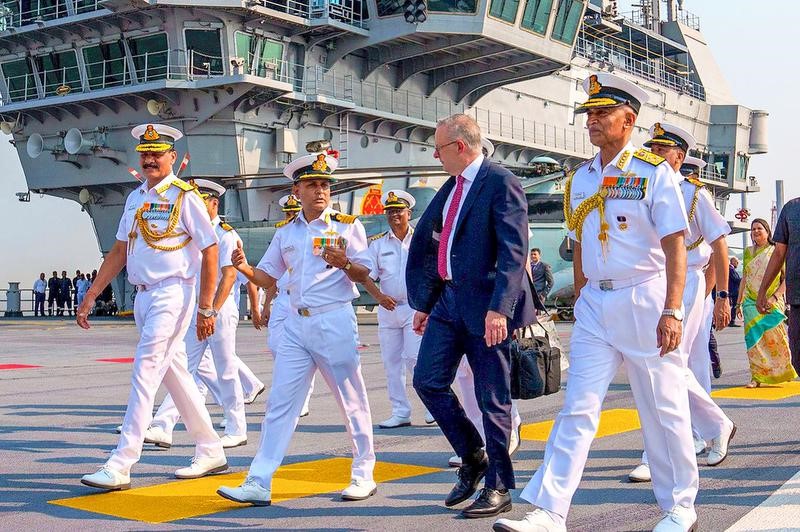Description

Disclaimer: Copyright infringement not intended.
Context: India is a top-tier security partner, says Australian Prime Minister Albanese. After a visit to the cricket stadium in Ahmedabad with Prime Minister Narendra Modi, Australian Prime Minister Anthony Albanese tweeted about the fierce but friendly sporting rivalry between the two nations. Albanese, the first leader of his country to make a bilateral visit to India since Malcolm Turnbull in 2017.
Details:
Historical perspective:
- The India-Australia bilateral relationship has been underpinned by the shared values of pluralistic, Westminster-style democracies, Commonwealth traditions, expanding economic engagement, and increasing high-level interaction.
- Several common traits, including strong, vibrant, secular, and multicultural democracies, a free press, an independent judicial system, and English language, serve as the foundation for closer co-operation and multifaceted interaction between the two countries.
- The end of the Cold War and beginning of India’s economic reforms in 1991 provided the impetus for the development of closer ties between the two nations.
- The ever-increasing numbers of Indian students travelling to Australia for higher education, and the growing tourism and sporting links, have played a significant role in strengthening bilateral relations.
- With the passage of time, ties evolved in the direction of a strategic relationship, alongside the existing economic engagement.
- With greater convergence of views on issues such as international terrorism, and a shared commitment to a rules-based order in the Indo-Pacific region, the two democracies have taken their cooperation to plurilateral formats, including the Quad (with the United States and Japan).
.jpeg)
Strategic ties:
- In September 2014, Australia’s Prime Minister Tony Abbott visited India, and in November that year, Modi became the first Indian Prime Minister to make an official visit to Australia after Rajiv Gandhi in 1986.
- He also became the first Indian PM to address a joint sitting of the Parliament of Australia.
- At the India-Australia Leaders’ Virtual Summit in June 2020, Modi and Prime Minister Scott Morrison elevated the bilateral relationship from the Strategic Partnership concluded in 2009 to a Comprehensive Strategic Partnership (CSP).
- There has been a series of high-level engagements and exchange of ministerial visits in 2022 and in 2023.
China factor:
- Ties between Australia and China were strained after Canberra in 2018 banned Chinese telecom firm Huawei from the 5G network.
- Later, it called for an inquiry into the origins of Covid-19, and slammed China’s human rights record in Xinjiang and Hong Kong.
- China responded by imposing trade barriers on Australian exports, and by cutting off all ministerial contact.
- India has been facing an aggressive Chinese military along the border. New Delhi and Canberra have been assessing the Chinese challenge since 2013.

Wide cooperation:
Economic cooperation:
- The Economic Cooperation Trade Agreement (ECTA) — the first free trade agreement signed by India with a developed country in a decade — entered into force in December 2022, and has resulted in an immediate reduction of duty to zero on 96% of Indian exports to Australia in value (that is 98% of the tariff lines) and zero duty on 85% of Australia’s exports (in value) to India.
- Bilateral trade was US$ 27.5 billion in 2021; with ECTA, there is potential for it to reach around US$ 50 billion in five years.
People-to-people ties:
- India is one of the top sources of skilled immigrants to Australia.
- As per the 2021 Census, around 9.76 lakh people in Australia reported their ancestry as Indian origin, making them the second largest group of overseas-born residents in Australia.
Education:
- The Mechanism for Mutual Recognition of Educational Qualifications (MREQ) was signed this year.
- This will facilitate mobility of students between India and Australia.
- Deakin University and University of Wollongong are planning to open campuses in India.
- More than 1 lakh Indian students are pursuing higher education degrees in Australian universities, making Indian students the second largest cohort of foreign students in Australia.

Defence cooperation:
- The 2+2 Ministerial Dialogue was held in September 2021, and the Deputy Prime Minister and Defence Minister of Australia visited in June 2022.
- The Mutual Logistics Support Agreement (MLSA) was concluded during the Virtual Summit in June 2020, and the two militaries held several joint exercises in 2022.
- Australia will host military operations with India, Japan, and the US in the “Malabar” exercises off the coast of Perth in August, and has invited India to join the Talisman Sabre exercises later this year.
- Australia will host Exercise Malabar for the first time, and India will, also for the first time, participate in Australia’s Talisman Sabre exercise.
- India is a top-tier security partner for Australia, Australian PM said during a visit onboard India’s indigenous aircraft carrierINS Vikrant
Clean energy:
- The countries signed a Letter of Intent on New and Renewable Energy in February 2022 which provides for cooperation towards bringing down the cost of renewable energy technologies, especially ultra low-cost solar and clean hydrogen.
- During the Virtual Summit in March 2022, India announced matching funds of AUD 10 million for Pacific Island Countries under Infrastructure for Resilient Island States (IRIS) and of AUD 10 million for Pacific Island Countries under International Solar Alliance (ISA).
Must read: https://www.iasgyan.in/daily-current-affairs/india-australia-relations-1
Must read: https://www.iasgyan.in/daily-current-affairs/ins-vikrant-1
|
PRACTICE QUESTION
Q) Discuss the influence of ‘China Factor’ in strengthening India-Australia Relations. (150 words)
|

https://epaper.thehindu.com/ccidist-ws/th/th_delhi/issues/28010/OPS/GR7AVIEPG.1+GH1AVJ8RS.1.html












